A Phased Approach to Increase Human Tolerance in Elephant Corridors to Link Protected Areas in Southern Mozambique
Abstract
:1. Introduction
2. Material and Methods
2.1. Phase 1–Satellite Tracking Elephants
Study Site
2.2. Phase 2—Cafeteria Experiments
2.2.1. Study Site
2.2.2. Plant Type Selection and Harvesting Criteria
2.2.3. Cafeteria Experiments
2.2.4. Data Analyses
2.3. Phase 3—Ensuring Human Safety
3. Results
3.1. Phase 1—Satellite Tracking Elephants
3.2. Phase 2—Cafeteria Experiments
3.3. Phase 3—Ensuring Human Safety
4. Discussion
5. Conclusions
Supplementary Materials
Author Contributions
Funding
Institutional Review Board Statement
Informed Consent Statement
Data Availability Statement
Acknowledgments
Conflicts of Interest
References
- Gobush, K.S.; Edwards, C.T.T.; Balfour, D.; Wittemyer, G.; Maisels, F.; Taylor, R.D. Loxodonta africana. In The IUCN Red List of Threatened Species; IUCN: Gland, Switzerland, 2021. [Google Scholar]
- Douglas-Hamilton, I. The current elephant poaching trend. Pachyderm 2009, 45, 154–157. [Google Scholar]
- Lindsay, K.; Chase, M.; Landen, K.; Nowak, K. The shared nature of Africa’s elephants. Biol. Conserv. 2017, 215, 260–267. [Google Scholar] [CrossRef]
- Booth, V.R.; Dunham, K.M. Elephant poaching in Niassa Reserve, Mozambique: Population impact revealed by combined survey trends for live elephants and carcasses. Oryx 2016, 50, 94–103. [Google Scholar] [CrossRef] [Green Version]
- Wall, J.; Wittemyer, G.; Klinkenberg, B.; LeMay, V.; Blake, S.; Strindberg, S.; Henley, M.D.; Vollrath, F.; Maisels, F.; Douglas-Hamilton, I. Human footprint and protected areas shape elephant range across Africa. Curr. Biol. 2021, 31, 2437–2445. [Google Scholar] [CrossRef]
- Gross, E.M.; Lahkar, B.P.; Subedi, N.; Nyirenda, V.R.; Lichtenfeld, L.L.; Jakoby, O. Does traditional and advanced guarding reduce crop losses due to wildlife? A comparative analysis from Africa and Asia. J. Nat. Conserv. 2019, 50, 125712. [Google Scholar] [CrossRef]
- Dunham, K.M.; Ghiurghi, A.; Cumbi, R.; Urbano, F. Human–wildlife conflict in Mozambique: A national perspective, with emphasis on wildlife attacks on humans. Oryx 2010, 44, 185–193. [Google Scholar] [CrossRef] [Green Version]
- Calabrese, A.; Calabrese, J.M.; Songer, M.; Wegmann, M.; Hedges, S.; Rose, R.; Leimgruber, P. Conservation status of Asian elephants: The influence of habitat and governance. Biodivers. Conserv. 2017, 26, 2067–2081. [Google Scholar] [CrossRef]
- Vogel, S.M.; Blumenthal, S.A.; de Boer, W.F.; Masake, M.; Newton, I.; Songhurst, A.C.; McCulloch, G.; Stronza, A.; Henley, M.D.; Coulson, T. Timing of dietary switching by savannah elephants in relation to crop consumption. Biol. Conserv. 2020, 249, 108703. [Google Scholar] [CrossRef]
- Sach, F.; Yon, L.; Henley, M.D.; Bedetti, A.; Buss, P.; de Boer, W.F.; Dierenfeld, E.S.; Gardner, A.; Langley-Evans, S.C.; Hamilton, E.; et al. Spatial geochemistry influences the home range of elephants. Sci. Total Environ. 2020, 729, 139066. [Google Scholar] [CrossRef]
- Osborn, F.V. Seasonal variation of feeding patterns and food selection by crop-raiding elephants in Zimbabwe. Afr. J. Ecol. 2004, 42, 322–327. [Google Scholar] [CrossRef]
- Chiyo, P.I.; Cochrane, E.P.; Naughton, L.; Basuta, G.I. Temporal patterns of crop raiding by elephants: A response to changes in forage quality or crop availability? Afr. J. Ecol. 2005, 43, 48–55. [Google Scholar] [CrossRef]
- Mumby, H.S.; Plotnik, J.M. Taking the elephants’ perspective: Remembering elephant behavior, cognition and ecology in human-elephant conflict mitigation. Front. Ecol. Evol. 2018, 6, 122. [Google Scholar] [CrossRef] [Green Version]
- Perera, B.M.A.O. The human-elephant conflict: A review of current status and mitigation methods. Gajah 2009, 30, 41–52. [Google Scholar]
- Enukwa, E.H. Human-Elephant conflict mitigation methods: A review of effectiveness and sustainability. J. Wildl. Biodivers. 2017, 1, 69–78. [Google Scholar] [CrossRef]
- Hoare, R. Lessons from 15 years of human-elephant conflict mitigation: Management considerations involving biological, physical and governance issues in Africa. Pachyderm 2012, 51, 60–74. [Google Scholar]
- Gross, E.M.; McRobb, R.; Gross, J. Cultivating alternative crops reduces crop losses due to African elephants. J. Pest Sci. 2016, 89, 497–506. [Google Scholar] [CrossRef]
- Gross, E.M.; Drouet-Hoguet, N.; Subedi, N.; Gross, J. The potential of medicinal and aromatic plants (MAPs) to reduce crop damages by Asian Elephants (Elephas maximus). Crop Prot. 2017, 100, 29–37. [Google Scholar] [CrossRef]
- Hanks, J. Transfrontier Conservation Areas (TFCAs) in Southern Africa: Their role in conserving biodiversity, socioeconomic development and promoting a culture of peace. J. Sustain. For. 2003, 17, 127–148. [Google Scholar] [CrossRef]
- Munthali, S.M. Transfrontier conservation areas: Integrating biodiversity and poverty alleviation in Southern Africa. In Natural Resources Forum; Blackwell Publishing Ltd.: Oxford, UK, 2007; Volume 31, pp. 51–60. [Google Scholar] [CrossRef]
- Hilty, J.; Worboys, G.L.; Keeley, A.; Woodley, S.; Lausche, B.; Locke, H.; Carr, M.; Pulsford, I.; Pittock, J.; White, J.W.; et al. Guidelines for conserving connectivity through ecological networks and corridors. Best Pract. Prot. Area Guidel. Ser. 2020, 30, 122. [Google Scholar] [CrossRef]
- Brennan, A.; Beytell, P.; Aschenborn, O.; Du Preez, P.; Funston, P.J.; Hanssen, L.; Kilian, J.W.; Stuart-Hill, G.; Taylor, R.D.; Naidoo, R. Characterizing multispecies connectivity across a transfrontier conservation landscape. J. Appl. Ecol. 2020, 57, 1700–1710. [Google Scholar] [CrossRef]
- Nelson, A.; Bidwell, P.; Sillero-Zubiri, C. A review of human-elephant conflict management strategies. In People & Wildlife, A Wildlife Conservation Research Unit, Born Free Foundation Partnership; Oxford University: Oxford, UK, 2003. [Google Scholar]
- Maslov, A.H. A theory of human motivation. In Psychological Review; 1943; Volume 50, pp. 370–396. [Google Scholar] [CrossRef] [Green Version]
- Chenje, I.; Johnson, R. The State of the Environment of the Southern Africa. Maseru, Harare; SADC: Maseru, Lesotho; Harare, Zimbabwe, 1998. [Google Scholar]
- Chitakira, M.; Torquebiau, E.; Ferguson, W. Community visioning in a transfrontier conservation area in Southern Africa paves the way towards landscapes combining agricultural production and biodiversity conservation. J. Environ. Plan. Manag. 2012, 55, 1228–1247. [Google Scholar] [CrossRef]
- SANParks. Elephant Management Plan: Kruger National Park 2011–2020; SANParks: Pretoria, South Africa, 2011. [Google Scholar]
- Wall, J.; Wittemyer, G.; Klinkenberg, B.; LeMay, V.; Douglas-Hamilton, I. Characterizing properties and drivers of long distance movements by elephants (Loxodonta africana) in the Gourma, Mali. Biol. Conserv. 2013, 157, 60–68. [Google Scholar] [CrossRef]
- Douglas-Hamilton, I. Proposal for “green hunting” of elephants as an alternative to legal sport hunting. Pachyderm 1997, 24, 30–32. [Google Scholar]
- Greyling, M.D.; McCay, M.; Douglas-Hamilton, I. Green Hunting as an alternative to lethal hunting. In Endangered Elephants: Past, Present, Future, Proceedings of the Symposium on Human–Elephant Relationships and Conflicts, Sri Lanka, September 2003; Jayewardene, J., Ed.; Biodiversity & Elephant Conservation Trust: Colombo, Sri Lanka, 2004; 228p. [Google Scholar]
- Furgeson, K.; Hanks, J. Fencing impacts: A review of the environmental, financial and social impacts of game and veterinary fencing in Africa with particular reference to the Great Limpopo and Kavango-Zambezi Transfrontier Conservation Areas Research. Pretoria: Mammal Research Institute. 2010. Available online: http://www.wcs_ahead.org/gltfca_grants/grants.html (accessed on 3 May 2021).
- HERD Meet the Herd. Available online: https://herd.org.za/meet-the-herd/ (accessed on 14 September 2022).
- Etheridge, C.J.; Derbyshire, E.J. Hibiscus Tea and Health: A Scoping Review of Scientific Evidence. Nutr. Food Technol. Open Accesss 2020, 6, 1–8. [Google Scholar] [CrossRef]
- King, L.E.; Lala, F.; Nzumu, H.; Mwambingu, E.; Douglas-Hamilton, I. Beehive fences as a multidimensional conflict-mitigation tool for farmers coexisting with elephants. Conserv. Biol. 2017, 31, 743–752. [Google Scholar] [CrossRef] [PubMed]
- van de Water, A.; King, L.E.; Arkajak, R.; Arkajak, J.; van Doormaal, N.; Ceccarelli, V.; Doornwaard, S.M.; Praet, V.; Owen, D.; Matteson, K. Beehive fences as a sustainable local solution to human-elephant conflict in Thailand. Conserv. Sci. Pract. 2020, 2, e260. [Google Scholar] [CrossRef]
- Ollerton, J.; Winfree, R.; Tarrant, S. How many flowering plants are pollinated by animals? Oikos 2011, 120, 321–326. [Google Scholar] [CrossRef]
- Hothorn, T.; Hornik, K.; Zeileis, A. Unbiased recursive partitioning: A conditional inference framework. J. Comput. Graph. Stat. 2006, 15, 651–674. [Google Scholar] [CrossRef] [Green Version]
- Strobl, C.; Malley, J.; Tutz, G. An introduction to recursive partitioning: Rationale, application, and characteristics of classification and regression trees, bagging, and random forests. Psychol. Methods 2009, 14, 323. [Google Scholar] [CrossRef] [Green Version]
- Lechowicz, M.J. The sampling characteristics of electivity indices. Oecologia 1982, 52, 22–30. [Google Scholar] [CrossRef] [PubMed]
- Burnham, K.; Anderson, D. Model Selection and Multimodel Inference: A Practical Information—Theoretic Approach, 2nd ed.; Springer: Berlin/Heidelberg, Germany, 2002. [Google Scholar]
- Barton, K. MuMIn: Multi-Model Inference. 2020. Available online: https://r-forge.r-project.org/R/?group_id=346.
- West, S.G.; Aiken, L.S.; Wu, W.; Taylor, A.B. Multiple regression: Applications of the basics beyond in personality research. In Handbook of Research Methods in Personality Psychology; Robins, R.W., Fraley, R.C., Krueger, R.F., Eds.; The Guilford Press: New York, NY, USA, 2000; pp. 573–601. [Google Scholar]
- Lenth, R.; Singmann, H.; Love, J.; Buerkner, P.; Herve, M. Emmeans: Estimated marginal means, aka least-squares means. R Package Version 2018, 1, 3. [Google Scholar]
- Zuur, A.F.; Ieno, E.N.; Walker, N.J.; Saveliev, A.A.; Smith, G.M. Mixed Effects Models and Extensions in Ecology with R; Springer: Berlin/Heidelberg, Germany, 2009; Volume 574. [Google Scholar] [CrossRef] [Green Version]
- Johannsmeier, M.F. Beeplants of South Africa; Strelitzia 37; SANBI: Pretoria, South Africa, 2016. [Google Scholar]
- Crane, E. Bees and Beekeeping: Science, Practice and World Resources; Heinemann Newnes: Oxford, UK, 1990. [Google Scholar]
- Matsika, T.A.; Adjetay, J.A.; Obopile, M.; Songhurst, A.C.; McCulloch, G.; Stronza, A. Alternative crops as a mitigation measure for elephant crop raiding in the eastern Okavango Panhandle. Pachyderm 2020, 61, 140–152. [Google Scholar]
- DAEFF. A profile of the South African Essential Oils Market Value Chain. Dep. Agric. For. Fish. 2017, 111, 94. [Google Scholar]
- Mashigo, M.; Combrinck, S.; Regnier, T.; Du Plooy, W.; Augustyn, W.; Mokgalaka, N. Chemical variations, trichome structure and antifungal activities of essential oils of Helichrysum splendidum from South Africa. South Afr. J. Bot. 2015, 96, 78–84. [Google Scholar] [CrossRef]
- Maroyi, A. Eriocephalus africanus: A review of its medicinal uses, phytochemistry and biological activities. J. Pharm. Sci. Res. 2019, 11, 3539–3546. [Google Scholar]
- Merle, H.; Verdeguer, M.; Blázquez, M.A.; Boira, H. Chemical composition of the essential oils from Eriocephalus africanus L. var. africanus populations growing in Spain. Flavour Fragr. J. 2007, 22, 461–464. [Google Scholar] [CrossRef]
- Kompelly, A.; Kompelly, S.; Vasudha, B.; Narender, B. Rosmarinus officinalis L.: An update review of its phytochemistry and biological activity. J. Drug Deliv. Ther. 2019, 9, 323–330. [Google Scholar] [CrossRef] [Green Version]
- Asadi-Samani, M.; Bahmani, M.; Rafieian-Kopaei, M. The chemical composition, botanical characteristic and biological activities of Borago officinalis: A review. Asian Pac. J. Trop. Med. 2014, 7, S22–S28. [Google Scholar] [CrossRef] [Green Version]
- Pather, N.; Viljoen, A.M.; Kramer, B. A biochemical comparison of the in vivo effects of Bulbine frutescens and Bulbine natalensis on cutaneous wound healing. J. Ethnopharmacol. 2011, 133, 364–370. [Google Scholar] [CrossRef]
- Singh, P.; Khan, M.; Hailemariam, H. Nutritional and health importance of Hibiscus sabdariffa: A review and indication for research needs. J. Nutr. Health Food Eng. 2017, 6, 00212. [Google Scholar] [CrossRef] [Green Version]
- Liu, N.Q.; Van der Kooy, F.; Verpoorte, R. Artemisia afra: A potential flagship for African medicinal plants? South Afr. J. Bot. 2009, 75, 185–195. [Google Scholar] [CrossRef] [Green Version]
- May, A.; Bovi, O.A.; Maia, N.B.; Barata, L.E.S.; Souza Rde, C.Z.; De Douza, E.M.R.; De Moraes, A.R.A.; Pinheiro, M.Q. Basil plants growth and essential oil yield in a production system with successive cuts. Bragantia 2017, 67, 385–389. [Google Scholar] [CrossRef]
- Shahrajabian, M.H.; Sun, W.; Cheng, Q. Chemical components and pharmacological benefits of Basil (Ocimum basilicum): A review. Int. J. Food Prop. 2020, 23, 1961–1970. [Google Scholar] [CrossRef]
- Jianu, C.; Pop, G.; TGruia, A.; Horhat, F.G. Chemical composition and antimicrobial activity of essential oils of lavender (Lavandula angustifolia) and lavandin (Lavandula × intermedia) grown in Western Romania. Int. J. Agric. Biol. 2013, 15, 772–776. [Google Scholar]
- DAEFF. A profile of the South African Sunflower Market Value Chain. Dep. Agric. For. Fish. 2019, 34. [Google Scholar]
- Weinmann, S. Impacts of Elephant Crop-Raiding on Subsistence Farmers and Approaches to Reduce Human-Elephant Farming Conflict in Sagalla, Kenya. 2018. Available online: https://scholarworks.umt.edu/etd/11194 (accessed on 28 April 2021).
- Nyirenda, S.P.; Sileshi, G.W.; Belmain, S.R.; Kamanula, J.F.; Mvumi, B.M.; Sola, P.; Nyirenda, G.K.; Stevenson, P.C. Farmers’ ethno-ecological knowledge of vegetable pests and pesticidal plant use in Malawi and Zambia. Afr. J. Agric. Res. 2011, 6, 1525–1537. [Google Scholar]
- Hamidpour, R.; Hamidpour, S.; Hamidpour, M.; Marshall, V.; Hamidpour, R. Pelargonium graveolens (Rose Geranium)-A novel therapeutic agent for antibacterial, antioxidant, antifungal and diabetics. Arch. Cancer Res. 2017, 5, 1–5. [Google Scholar] [CrossRef] [Green Version]
- Haque, A.N.M.A.; Remadevi, R.; Naebe, M. Lemongrass (Cymbopogon): A review on its structure, properties, applications and recent developments. Cellulose 2018, 25, 5455–5477. [Google Scholar] [CrossRef]
- Brunkhorst, D.J. Bioregional Planning: Resource Management beyond the New Millennium; Harwood Academic Publishers: Reading, UK, 2000. [Google Scholar]
- IUCN. Benefits Beyond Boundaries. In Proceedings of the 5th IUCN World Parks Congress 2000, Durban, South Africa, 8–17 September 2003; IUCN: Gland, Switzerland, 2005. [Google Scholar]
- Green, S.E.; Davidson, Z.; Kaaria, T.; Doncaster, C.P. Do wildlife corridors link or extend habitat? Insights from elephant use of a Kenyan wildlife corridor. Afr. J. Ecol. 2018, 56, 860–871. [Google Scholar] [CrossRef] [Green Version]
- Graham, M.D.; Douglas-Hamilton, I.; Adams, W.M.; Lee, P.C. The movement of African elephants in a human-dominated land-use mosaic. Anim. Conserv. 2009, 12, 445–455. [Google Scholar] [CrossRef]
- Thorsell, J. Parks on the Borderline: Experience in Transfrontier Conservation; IUCN: Gland, Switzerland, 1990. [Google Scholar]
- Yang, W.; Ma, Y.; Jing, L.; Wang, S.; Sun, Z.; Tang, Y.; Li, H. Differential Impacts of Climatic and Land Use Changes on Habitat Suitability and Protected Area Adequacy across the Asian Elephant’s Range. Sustainability 2022, 14, 4933. [Google Scholar] [CrossRef]
- Parker, G.E.; Osborn, F.V. Investigating the potential for chilli Capsicum spp. to reduce human-wildlife conflict in Zimbabwe. Oryx 2006, 40, 343–346. [Google Scholar] [CrossRef] [Green Version]
- Schmitt, M.H.; Ward, D.; Shrader, A.M. Incorporating secondary metabolites, tannin-binding proteins, and diet breadth into carrying-capacity models for African elephants. Ecol. Model. 2016, 332, 8–18. [Google Scholar] [CrossRef]
- Cook, R.M.; Parrini, F.; Henley, M.D. Elephant movement patterns in relation to human inhabitants in and around the Great Limpopo Transfrontier Park. Koedoe Afr. Prot. Area Conserv. Sci. 2015, 57, 1–7. [Google Scholar] [CrossRef] [Green Version]
- South African Essential Oil Producers’ Association. Essential oils in SA—An industry budding with opportunity. Pharm. Cosmet. Rev. 2021, 48, 49. [Google Scholar]
- Ndlovu, N.; Neumann, F.H.; Henley, M.D.; Cook, R.M.; Reynolds, C. Melissopalynological investigations of seasonal honey samples from the Greater Kruger National Park, South Africa. Palynology, in review. 2023. [Google Scholar]
- Gross, E.M. Tackling Routes to Coexistence: Human-Elephant Conflict in Sub-Saharan Africa; GIZ Partnership against Poaching and Illegal Wildlife Trade: Bonn, Germany, 2019; 86p. [Google Scholar]
- Young, K.D.; Ferreira, S.M.; van Aarde, R.J. The influence of increasing population size and vegetation productivity on elephant distribution in the Kruger National Park. Austral. Ecol. 2009, 34, 329–342. [Google Scholar] [CrossRef]
- Birkett, P.J.; Vanak, A.T.; Muggeo, V.M.; Ferreira, S.M.; Slotow, R. Animal perception of seasonal thresholds: Changes in elephant movement in relation to rainfall patterns. PLoS ONE 2012, 7, e38363. [Google Scholar] [CrossRef] [Green Version]
- Druce, H.C.; Pretorius, K.; Slotow, R. The response of an elephant population to conservation area expansion: Phinda Private Game Reserve, South Africa. Biol. Conserv. 2008, 141, 3127–3138. [Google Scholar] [CrossRef]
- Saura, S.; Bodin, Ö.; Fortin, M.J. Stepping stones are crucial for species’ long-distance dispersal and range expansion through habitat networks. J. Appl. Ecol. 2014, 51, 171–182. [Google Scholar] [CrossRef]
- Berzaghi, F.; Longo, M.; Ciais, P.; Blake, S.; Bretagnolle, F.; Vieira, S.; Scaranello, M.; Scarascia-Mugnozza, G.; Doughty, C.E. Carbon stocks in central African forests enhanced by elephant disturbance. Nat. Geosci. 2019, 12, 725–729. [Google Scholar] [CrossRef]
- Sandhage-Hofmann, A.; Linstädter, A.; Kindermann, L.; Angombe, S.; Amelung, W. Conservation with elevated elephant densities sequesters carbon in soils despite losses of woody biomass. Glob. Change Biol. 2021, 27, 4601–4614. [Google Scholar] [CrossRef] [PubMed]
- Bunney, K.; Bond, W.; Henley, M.D. Seed dispersal kernel of the largest surviving megaherbivore—The African savanna elephant. Biotropica 2017, 49, 395–401. [Google Scholar] [CrossRef]
- Goldman, M.J.; Jagadeesh, S.N.; Ngimojino, T.M.O.; Gowda, L.M. Women’s stories and knowledge of wildlife and conservation practice in northern Tanzania and South India. Oryx 2021, 55, 818–826. [Google Scholar] [CrossRef]
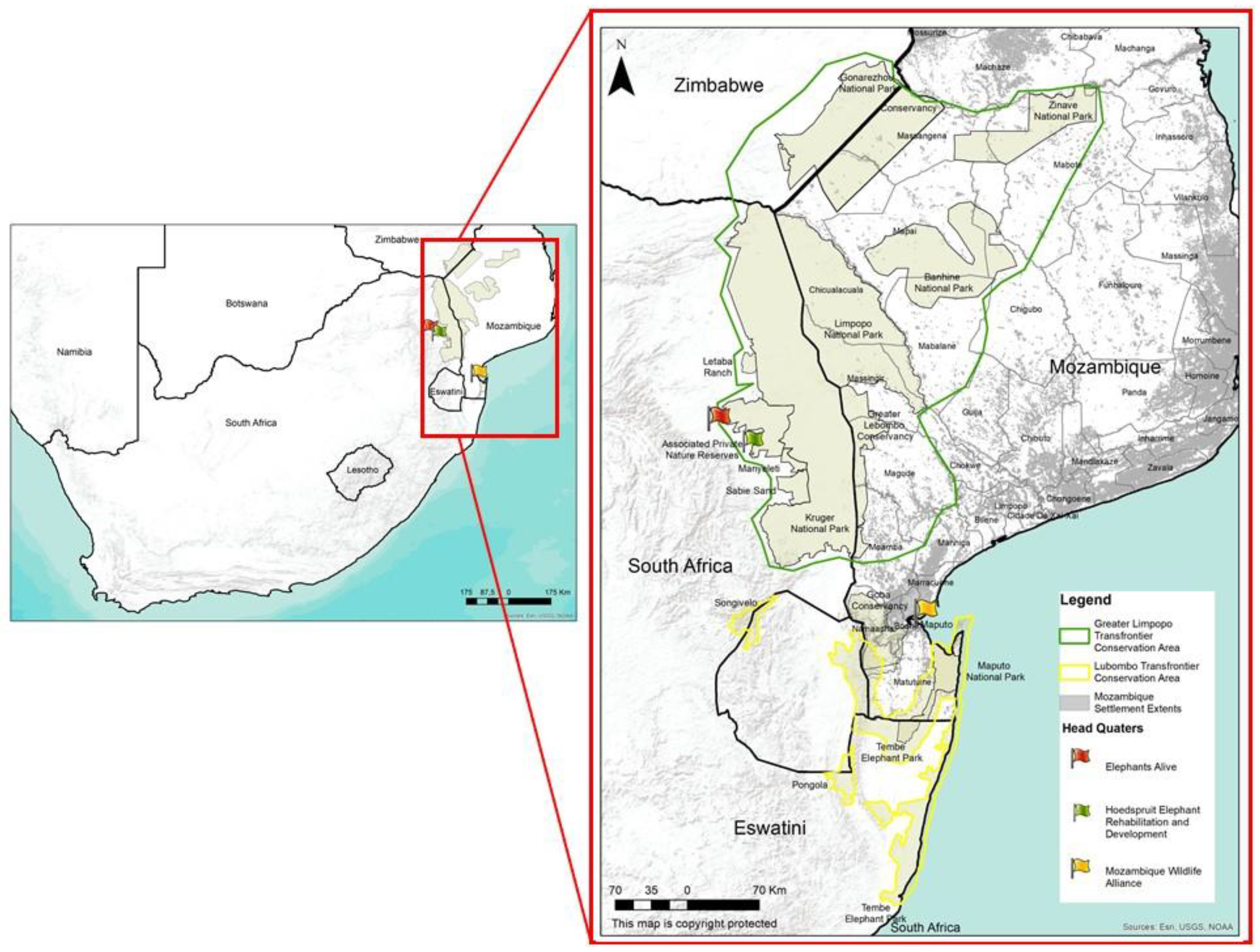
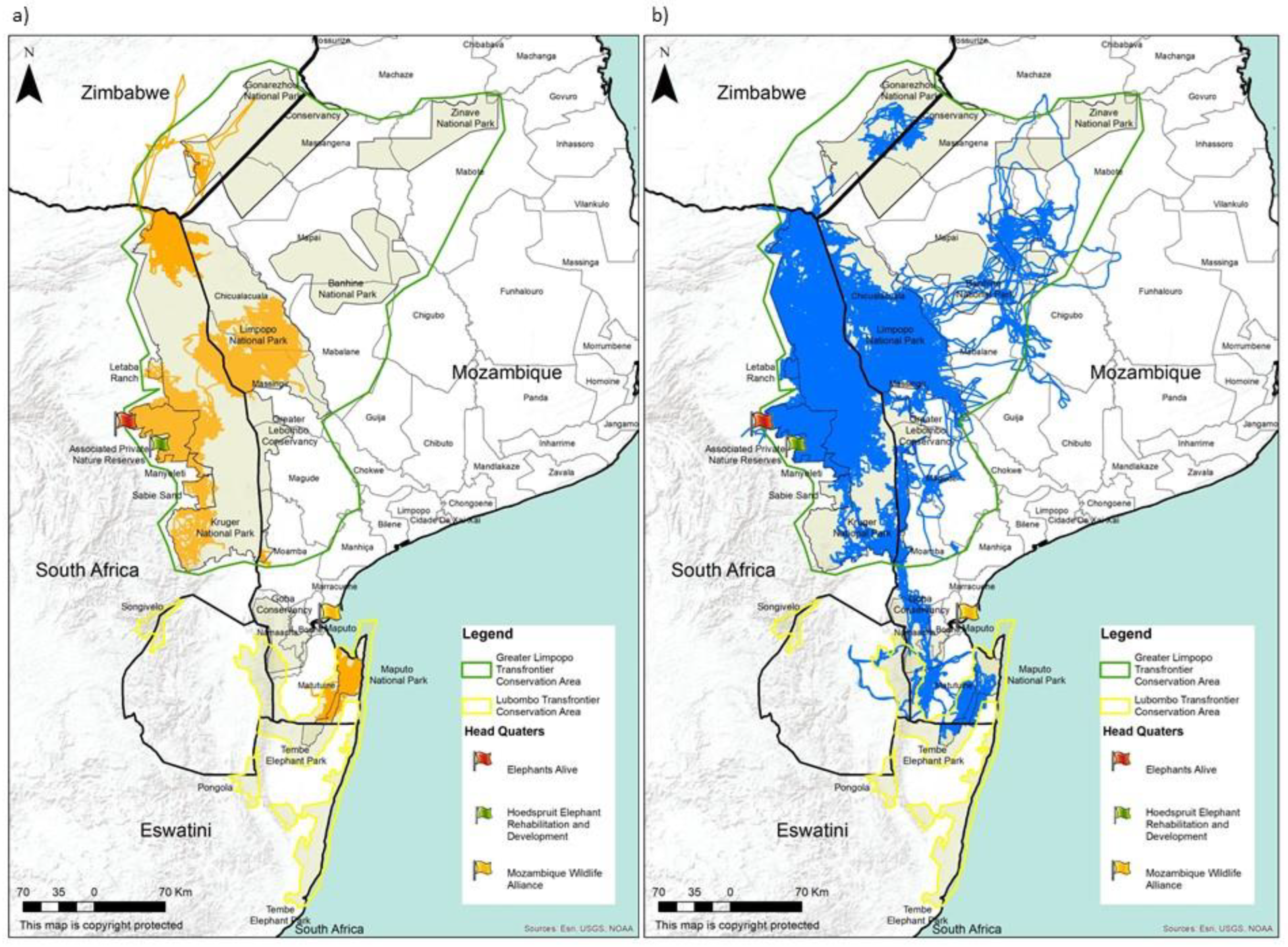
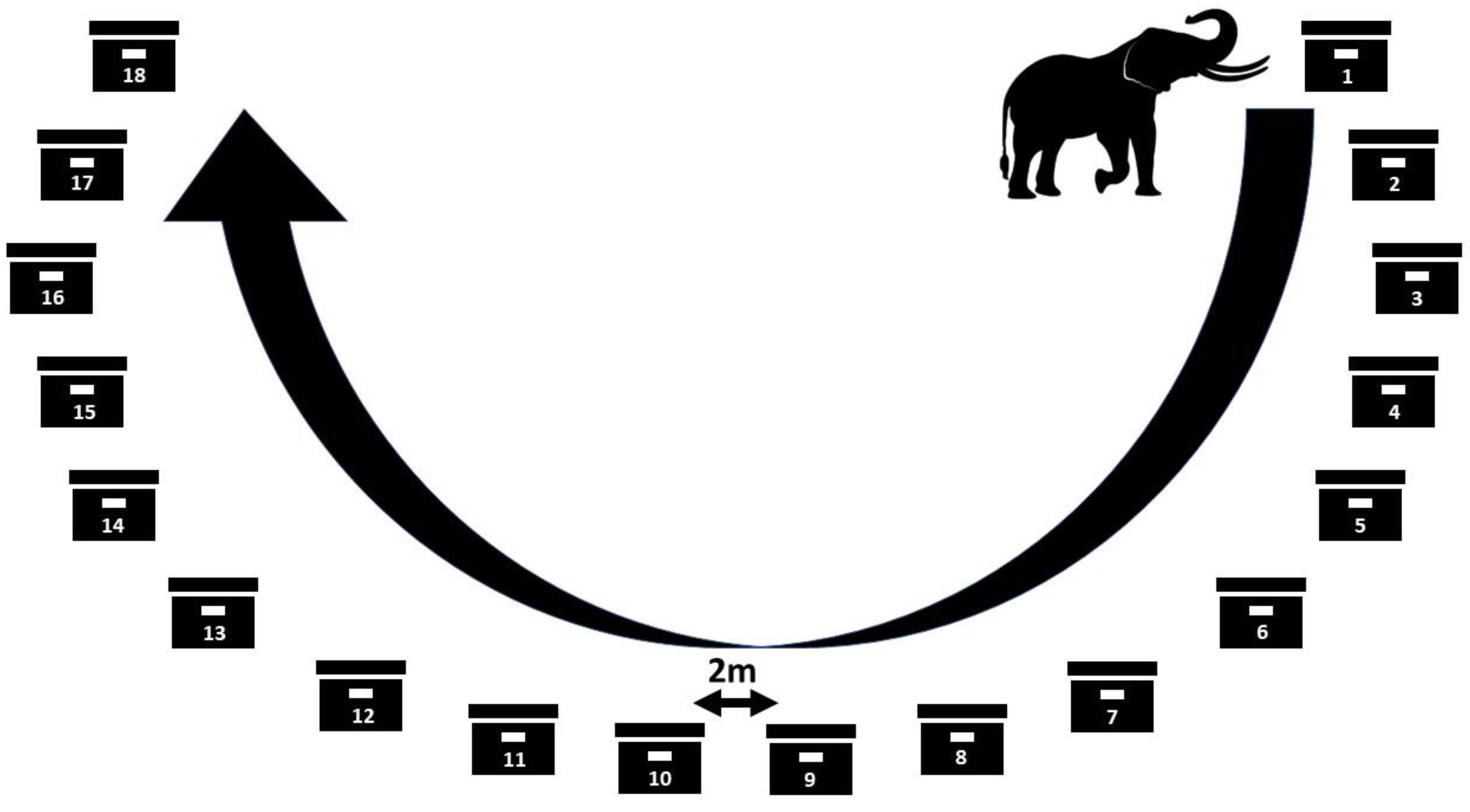

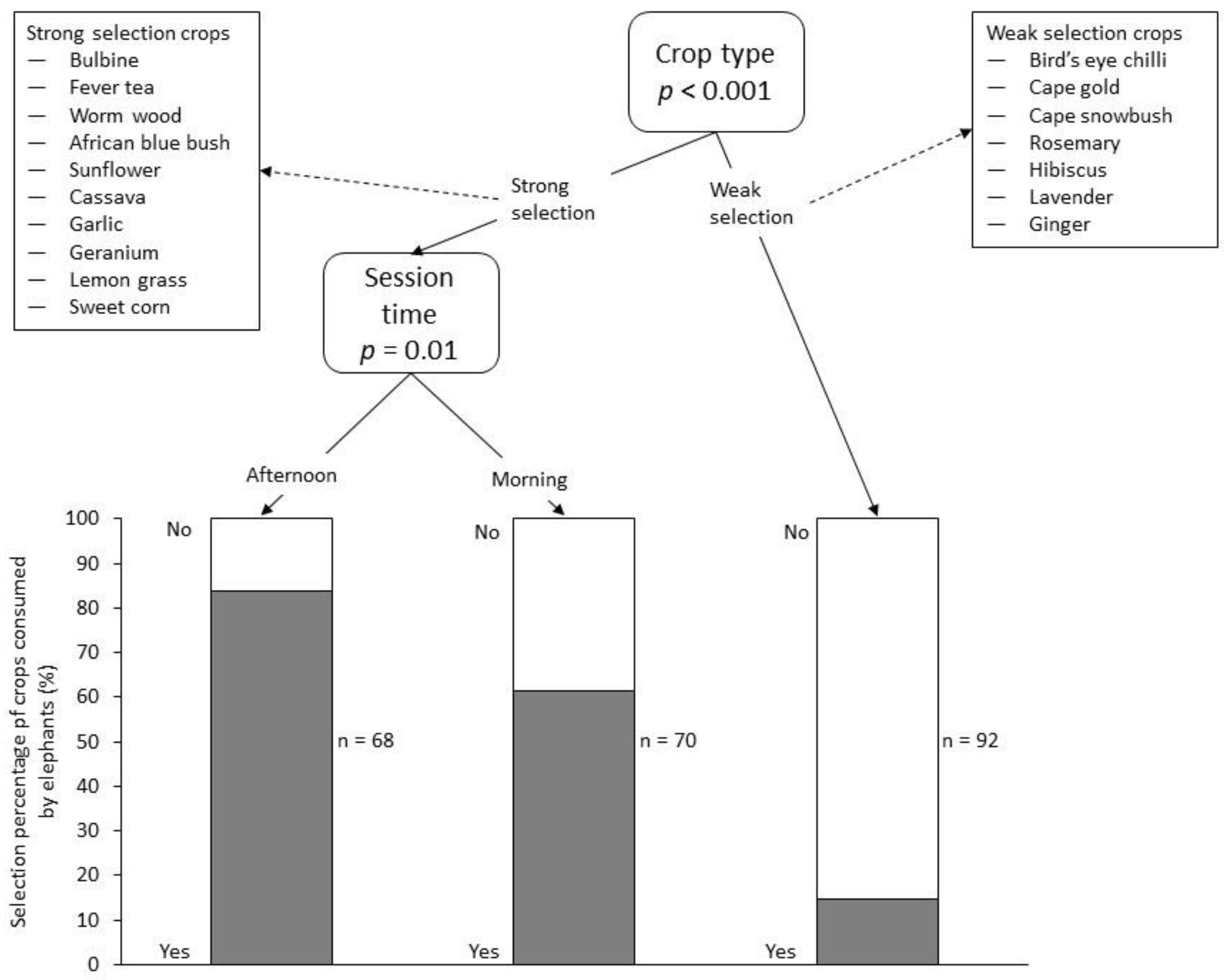
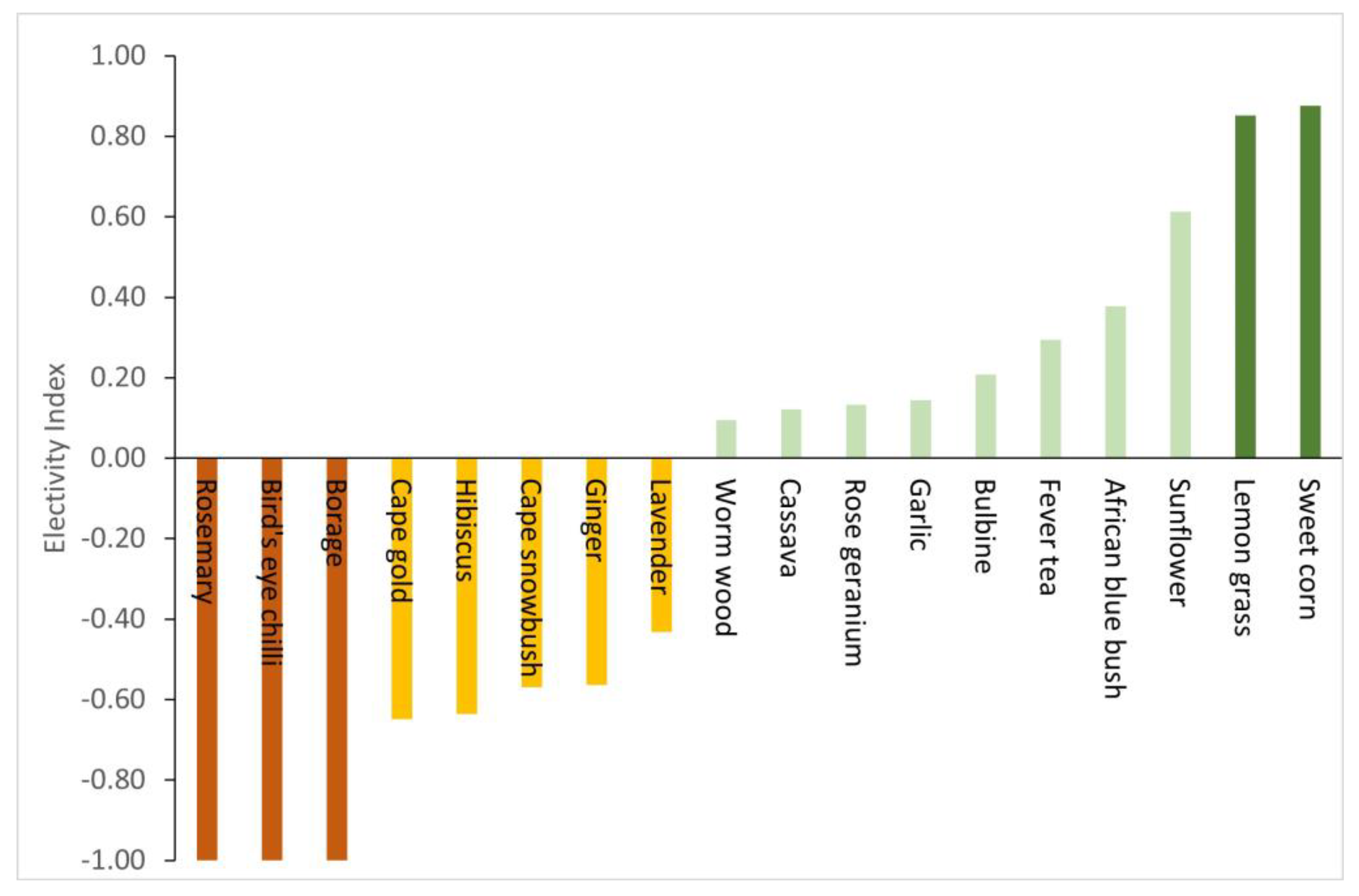
| Categories | Score | Motivation |
|---|---|---|
| Broader life cycle characteristics | B | |
| Indigenous & perennial | 1 | Indigenous plants would be more resistant to pests and if perennial, less labour intensive to farm |
| Indigenous & annual | 2 | Indigenous plants would be more resistant to pests and if annual, more labour intensive to farm |
| Exotic & perennial | 3 | Non-native species are usually very susceptible to pests and if perennial, less labour intensive to farm |
| Exotic & annual | 4 | Non-native species are usually very susceptible to pests and if annual, more labour intensive to farm |
| Growth requirements | G | |
| Low rainfall dependent, any soil type & drought tolerant | 1 | Well adapted to arid regions, doesn’t require rich soils and can withstand droughts |
| Medium rainfall dependent, nutrient rich/any soil type & drought tolerant | 2 | Adapted to medium rainfall, may or may not depend on particular soil types but still drought resistant |
| Medium rainfall dependent, nutrient rich/any soil type & drought intolerant | 3 | Adapted to medium rainfall, may or may not depend on particular soil types but not drought resistant |
| High rainfall dependent, nutrient rich/any soil type & drought intolerant | 4 | Requires high rainfall, may or may not depend on a particular soil type and not drought resistant |
| Economic value | E | |
| Has food-, essential oil-, medicinal- and bee fodder value | 1 | A very versatile plant type that has a very wide market value with the processing thereof adaptable to the demand |
| Has only three of the four potential value types | 2 | A versatile plant type that can adapt to different market demands |
| Has only two of the four potential value types | 3 | A plant type that has economic value, but which is limited in terms of what markets it can serve |
| Has only one of the four potential value types | 4 | A plant type that is specialised to only serve one market type |
| Palatability | P | |
| Was not eaten/ignored by elephants/spat out after tasting | 1 | Strongly avoided |
| Mostly played with the plants and didn’t consume them | 2 | Avoided |
| Showed some interest and ate parts of the plant but played with other parts | 3 | Edible |
| Readily consumed all plant parts each time | 4 | Favoured |
| Crop | Latin Name | Origin | Native to Southern Africa | Life Cycle | Growing Condition | Drought Tolerant | Economic Value | Palatability | Scoring | ||||||||
|---|---|---|---|---|---|---|---|---|---|---|---|---|---|---|---|---|---|
| Rainfall | Soils | Food | Oil | Med | Bee | to Elephants | B | G | E | P | O | ||||||
| Borage | Borago officinalis | Middle East | No | Annual | Low | Any | Yes | N * | Strongly avoid | 4 | 1 | 1 | 1 | 7 | |||
| Bird’s eye chilli | Capsicum frutescens | Africa & southeast Asia | Yes | Perennial | Medium | Any | Yes | Strongly avoid | 1 | 2 | 2 | 1 | 6 | ||||
| Rosemary | Rosmarinus officinalis | Mediterranean region | No | Perennial | Low | Any | Yes | N | Strongly avoid | 3 | 1 | 1 | 1 | 6 | |||
| Cape gold | Helichrysum splendidum | Africa & Ethiopia | Yes | Perennial | Low | Any | Yes | P * | Avoid | 1 | 1 | 2 | 2 | 6 | |||
| Cape snowbush | Eriocephalus africanus | South Africa | No | Perennial | Low | Any | Yes | N | Avoid | 3 | 1 | 2 | 2 | 8 | |||
| Ginger | Zingiber officinale | Southeast Asia, India & China | No | Annual | High | Nutrient rich | No | Avoid | 4 | 4 | 2 | 2 | 12 | ||||
| Hibiscus | Hibiscus sabdariffa | Africa | Yes | Perennial | Medium | Any | No | N | Avoid | 1 | 3 | 1 | 2 | 7 | |||
| Lavender | Lavandula x intermedia | France | No | Perennial | Low | Any | Yes | N | Avoid | 3 | 1 | 2 | 2 | 8 | |||
| Bulbine | Bulbine frutescens | South Africa | Yes | Perennial | Low | Any | Yes | Gel | P | Edible | 1 | 1 | 2 | 3 | 7 | ||
| Cassava | Manihot esculenta | South America | No | Perennial | Medium | Any | Yes | N | Edible | 3 | 2 | 3 | 3 | 11 | |||
| Fever tea | Lippia javanica | South Africa | Yes | Perennial | Low | Any | Yes | N | Edible | 1 | 1 | 2 | 3 | 7 | |||
| Garlic | Allium sativum | Middle Asia | No | Annual | Medium | Nutrient rich | Yes | Edible | 4 | 2 | 2 | 3 | 11 | ||||
| Geranium | Pelargonium graveolens | South Africa | No | Perennial | Medium | Nutrient rich | No | Edible | 3 | 3 | 3 | 3 | 12 | ||||
| African blue bush | Ocimum americanum | Africa, India & southeast Asia | Yes | Perennial | Medium | Nutrient rich | No | N | Edible | 1 | 3 | 1 | 3 | 8 | |||
| Worm wood | Artemisia afra | Africa & Ethiopia | Yes | Perennial | Low | Any | Yes | P | Edible | 1 | 1 | 2 | 3 | 7 | |||
| Sunflower | Helianthus | North America | No | Annual | Low | Any | Yes | Food | P | Favour | 4 | 1 | 1 | 3 | 9 | ||
| Lemon grass | Cymbopogon | Southeast Asia | No | Perennial | High | Nutrient rich | No | Favour | 3 | 4 | 2 | 4 | 13 | ||||
| Sweet corn | Zea mays convar. saccharata var. rugosa | South America | No | Annual | High | Nutrient rich | No | Favour | 4 | 4 | 4 | 4 | 16 | ||||
| Type | Overall Score | Literature Description | Reference |
|---|---|---|---|
| Bird’s eye chilli | 6 | Unpalatable | b [45], a [47] |
| Cape gold | 6 | Unknown | o [48], m [49], b [45] |
| Cape snowbush | 6 | Unknown | o [50], m [51], b [45] |
| Rosemary | 6 | Unknown | o [48], m [52], b [45] |
| Borage | 7 | Unknown | o, m [53], b [45] |
| Bulbine | 7 | Unknown | o, m [54], b [45] |
| Fever tea | 7 | Unknown | o [48], m [50], b [45] |
| Hibiscus | 7 | Unknown | m [55], b [45] |
| Worm wood | 7 | Unknown | o [48], m [56], b [45] |
| African blue bush | 8 | Unknown | o [57], m [58], b [45] |
| Lavender | 8 | Unknown | o [48], m [59], b [45] |
| Sunflower | 9 | Unpalatable | o [60], b [45], a [61] |
| Cassava | 11 | Palatable | b [45], a [62] |
| Garlic | 11 | Unpalatable | o [48], a [17] |
| Geranium | 12 | Unknown | o [48], m [63] |
| Ginger | 12 | Unpalatable | o [48], a [17] |
| Lemon grass | 13 | Unpalatable | o [48], m [64], a [17] |
| Sweet corn | 16 | Palatable | a [62] |
| Description | 1st 6 mon. | 2nd 6 mon. | 1 Year | Prop. diff. between Periods |
|---|---|---|---|---|
| Number of conflict cases | 91 | 179 | 270 | 34% vs. 66% |
| Conflict cases involving elephants | 54 | 121 | 175 | 31% vs. 69% |
| Conflict cases involving predators and other ungulates | 37 | 58 | 95 | 39% vs. 61% |
| Number of responses by the RRU | 82 | 39 | 121 | 68% vs. 32% |
| Number of successful chases | 64 | 28 | 92 | 70% vs. 30% |
| Number of unsuccessful chases | 18 | 10 | 28 | 64% vs. 36% |
Disclaimer/Publisher’s Note: The statements, opinions and data contained in all publications are solely those of the individual author(s) and contributor(s) and not of MDPI and/or the editor(s). MDPI and/or the editor(s) disclaim responsibility for any injury to people or property resulting from any ideas, methods, instructions or products referred to in the content. |
© 2023 by the authors. Licensee MDPI, Basel, Switzerland. This article is an open access article distributed under the terms and conditions of the Creative Commons Attribution (CC BY) license (https://creativecommons.org/licenses/by/4.0/).
Share and Cite
Henley, M.D.; Cook, R.M.; Bedetti, A.; Wilmot, J.; Roode, A.; Pereira, C.L.; Almeida, J.; Alverca, A. A Phased Approach to Increase Human Tolerance in Elephant Corridors to Link Protected Areas in Southern Mozambique. Diversity 2023, 15, 85. https://doi.org/10.3390/d15010085
Henley MD, Cook RM, Bedetti A, Wilmot J, Roode A, Pereira CL, Almeida J, Alverca A. A Phased Approach to Increase Human Tolerance in Elephant Corridors to Link Protected Areas in Southern Mozambique. Diversity. 2023; 15(1):85. https://doi.org/10.3390/d15010085
Chicago/Turabian StyleHenley, Michelle D., Robin M. Cook, Anka Bedetti, Jessica Wilmot, Adine Roode, Carlos L. Pereira, João Almeida, and António Alverca. 2023. "A Phased Approach to Increase Human Tolerance in Elephant Corridors to Link Protected Areas in Southern Mozambique" Diversity 15, no. 1: 85. https://doi.org/10.3390/d15010085
APA StyleHenley, M. D., Cook, R. M., Bedetti, A., Wilmot, J., Roode, A., Pereira, C. L., Almeida, J., & Alverca, A. (2023). A Phased Approach to Increase Human Tolerance in Elephant Corridors to Link Protected Areas in Southern Mozambique. Diversity, 15(1), 85. https://doi.org/10.3390/d15010085







